West Ham
In the early 1890s, the Canning Town and West Ham area of East London was awash with football clubs. In 1895, Arnold Hills, Chairman and Managing Director of the Thames Ironworks & Shipbuilding Company decided to form a works team to be called Thames Ironworks FC. Hills was himself a prominent player, having played for Oxford University in the FA Cup final of 1877 and won an England cap two years later. The club initially played in 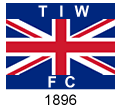 Harrovian blue, latterly with a union flag on the left breast. Research by Grant Hole has brought evidence to light that in 1895, the club took over Castle Swifts FC, the works side of the Castle Mail Packet Company. Thames Ironworks acquired a set of light blue and white kits from the Swifts and wore these for the first time in the second half of a rain-soaked game against Novocastrians in November 1897. "Castle blue" shirts, white knickers and vermillion socks became the team's colours until 1900.
Harrovian blue, latterly with a union flag on the left breast. Research by Grant Hole has brought evidence to light that in 1895, the club took over Castle Swifts FC, the works side of the Castle Mail Packet Company. Thames Ironworks acquired a set of light blue and white kits from the Swifts and wore these for the first time in the second half of a rain-soaked game against Novocastrians in November 1897. "Castle blue" shirts, white knickers and vermillion socks became the team's colours until 1900.
There is a story that in the summer of 1899 Bill Dove, a sprinter of national repute who was involved in coaching the Ironworks team, was challenged to a race with four Aston Villa players at a fair in Birmingham. Dove won but the Villa men could not pay the wager so one of them pinched a set of claret and blue shirts from his club (he was responsible for doing the laundry) to settle the bet. There is, however, no evidence that the team ever wore their new shirts.
In June 1900, the club was formally wound up. The Ironworks had become a company owned by shareholders who were not prepared to fund the team. For every share sold in the new company to the public, Arnold Hill bought one too. The club was allowed to continue playing at the Ironworks sports ground for a generous rent and Arnold Hills became the president of the new West Ham United, who signed professional players. A claret stripe was added to the shorts, claret being the commercial colour of the Ironworks, and the old vermilion socks were replaced by black ones. The next season a claret hoop was added to the shirt, which became known as the "Union Jack" strip and in 1903 the now familiar claret shirts with light blue sleeves were adopted. The team continued to be known as the "red, white and blues" for some time.
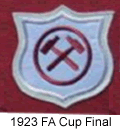 West Ham retain their connection to the older club through their badge (a pair of crossed riveting hammers) and their nickname (The Hammers). The new club took over Ironworks' place in the Southern League and steadily built a reputation. In 1919 West Ham were elected to Division Two when the League was expanded after World War One. In 1923 the Hammers won promotion to the First Division and appeared in the first Wembley FA Cup Final where they lost 0-2 to Bolton. This match is probably the first in which the famous crossed hammers appeared. Nine years later, the club was relegated back to
West Ham retain their connection to the older club through their badge (a pair of crossed riveting hammers) and their nickname (The Hammers). The new club took over Ironworks' place in the Southern League and steadily built a reputation. In 1919 West Ham were elected to Division Two when the League was expanded after World War One. In 1923 the Hammers won promotion to the First Division and appeared in the first Wembley FA Cup Final where they lost 0-2 to Bolton. This match is probably the first in which the famous crossed hammers appeared. Nine years later, the club was relegated back to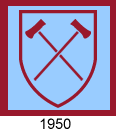 Division Two where they stayed for the next 26 years.
Division Two where they stayed for the next 26 years.
From 1950 the crossed hammer badge was worn regularly, usually embroidered in claret on 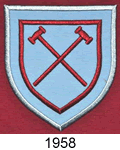 a light blue patch but with several variations until it was retired in 1966. (A good example is the 1958 version, embroidered onto a shield-shaped patch and in which the rivetting hammers have a different shape.)
a light blue patch but with several variations until it was retired in 1966. (A good example is the 1958 version, embroidered onto a shield-shaped patch and in which the rivetting hammers have a different shape.)
In 1954-55 West Ham played a number of European sides in friendlies under floodlights, wearing shirts made from shiny, rayon material.
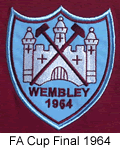 In 1958 The Hammers won the Second Division championship in the season that the
In 1958 The Hammers won the Second Division championship in the season that the 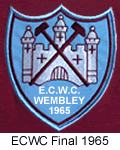 young Bobby Moore made his debut. Three years later Ron Greenwood became manager and West Ham's golden age began. In 1964 they won the FA Cup for the first time, beating Preston North End 3-2. A year later they were back at Wembley in the European Cup Winners' Cup final, defeating TSV Munich 1860 2-0. The crests worn in these important matches added Boleyn Castle, a local landmark, to the crossed hammers.
young Bobby Moore made his debut. Three years later Ron Greenwood became manager and West Ham's golden age began. In 1964 they won the FA Cup for the first time, beating Preston North End 3-2. A year later they were back at Wembley in the European Cup Winners' Cup final, defeating TSV Munich 1860 2-0. The crests worn in these important matches added Boleyn Castle, a local landmark, to the crossed hammers.
In 1966 the Hammers lost in the League Cup final but the club will always be remembered for providing three key members of England's victorious World Cup winning side, Martin Peters, Geoff Hurst and Bobby Moore.
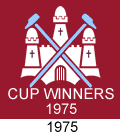 It would be eight years before West Ham won more silverware, winning the FA Cup by beating Fulham (now captained by Bobby Moore) in 1975. A year later they reached the European Cup Winners' Cup final for the second time but lost to Anderlecht. The club unveiled a prototype of their new yoked strip, designed by Admiral, in this match.
It would be eight years before West Ham won more silverware, winning the FA Cup by beating Fulham (now captained by Bobby Moore) in 1975. A year later they reached the European Cup Winners' Cup final for the second time but lost to Anderlecht. The club unveiled a prototype of their new yoked strip, designed by Admiral, in this match.
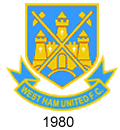 In 1978 West Ham were relegated and while in Division Two they won the FA Cup for the third time, beating hot favourites Arsenal in the final. A year later they were back in Division One having won the Second Division title.
In 1978 West Ham were relegated and while in Division Two they won the FA Cup for the third time, beating hot favourites Arsenal in the final. A year later they were back in Division One having won the Second Division title.
Adidas took over as West Ham's kit supplier for their first season back in the top division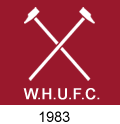 and their new strips featured a redesigned crest. This was dropped in 1983 in favour of a simple crossed hammer design but it was reinstated in 1985. After 1987 the colours were changed from gold on blue to light blue on claret.
and their new strips featured a redesigned crest. This was dropped in 1983 in favour of a simple crossed hammer design but it was reinstated in 1985. After 1987 the colours were changed from gold on blue to light blue on claret.
In 1986 West Ham achieved their highest ever League placing, third in the First Division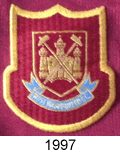 behind Liverpool and Everton. Between 1989 and 1993 West Ham were relegated twice and promoted twice, finally enjoying a settled period in the Premier league that lasted until 2003 when once again they were relegated.
behind Liverpool and Everton. Between 1989 and 1993 West Ham were relegated twice and promoted twice, finally enjoying a settled period in the Premier league that lasted until 2003 when once again they were relegated.
In 1997 the crest was given a facelift.
On 17 May 2010, West Ham and Newham Borough Council submitted a plan to take over the Olympic Stadium following the 2012 Olympic Games. A rival bid from Tottenham Hotspur was rejected but the future of West Ham's plan was thrown into doubt by an objection from Leyton Orient, whose ground is less than a mile from the new stadium.
West Ham United is a club of strong traditions. The claret and blue shirts may have been re-interpreted over the last 20 years but the classic 1960s design worn by Moore, Peters and Hurst remains the standard by which they are judged. More significantly, the club has always placed a premium on playing open, attacking football regardless of whether they are fighting relegation or winning silverware. In 2011, the Hammers were relegated to the Championship, throwing further doubt on the viability of the proposed move into the Olympic Stadium. A quick return to the top flight would be necessary if the club were to attract crowds sufficiently large for a ground with a planned capacity of 60,000.
In October 2011, negotiations over the move to the new Olympic Stadium collapsed after an anonymous complaint to the European Commission was made, alleging that a £40m loan from Newham Council amounted to state aid. Both Spurs and Leyton Orient had also given notice that they would appeal against a decision to dismiss their original objections giving rise to fears that legal action could rumble on through the courts for years to come.
